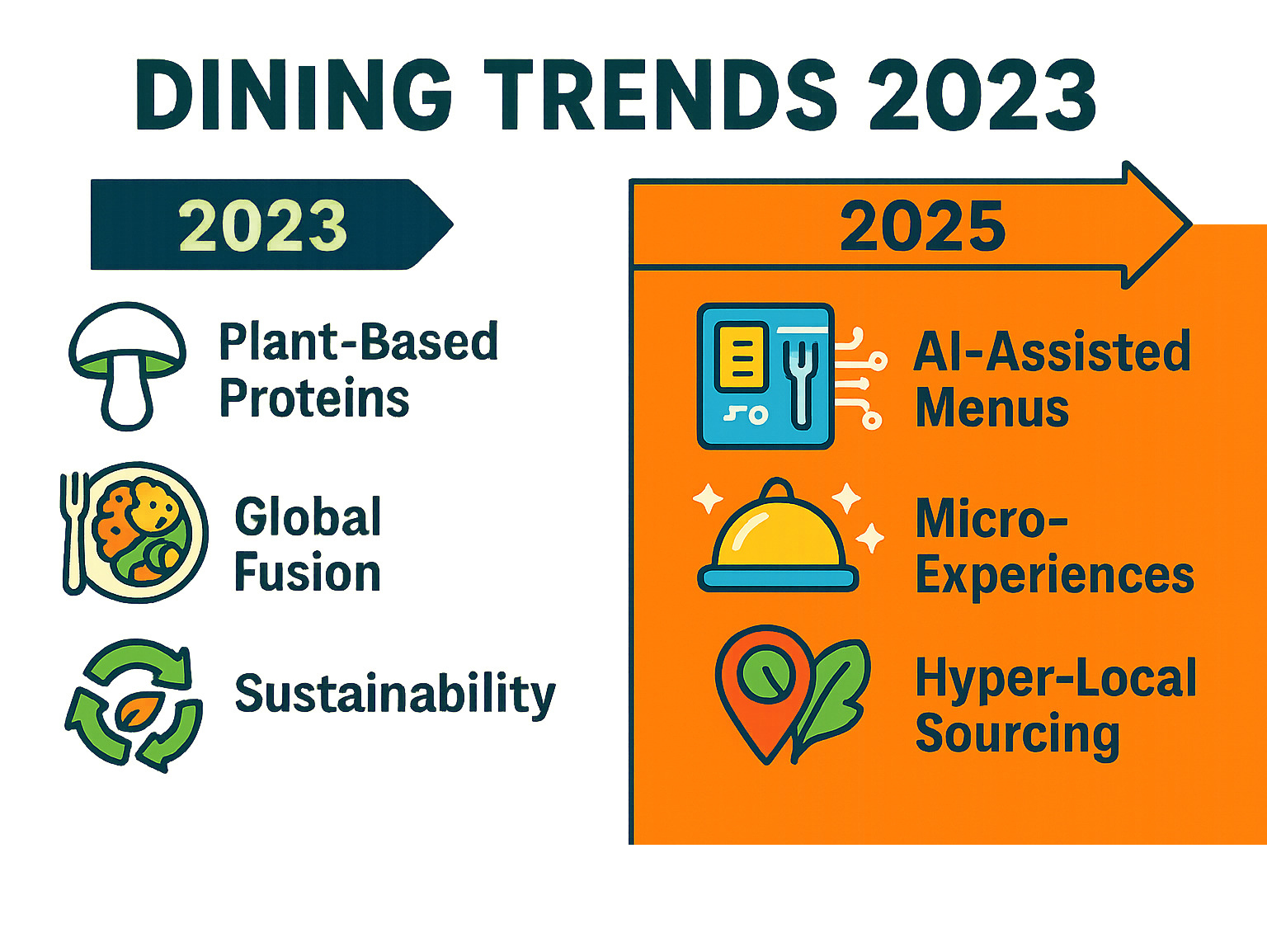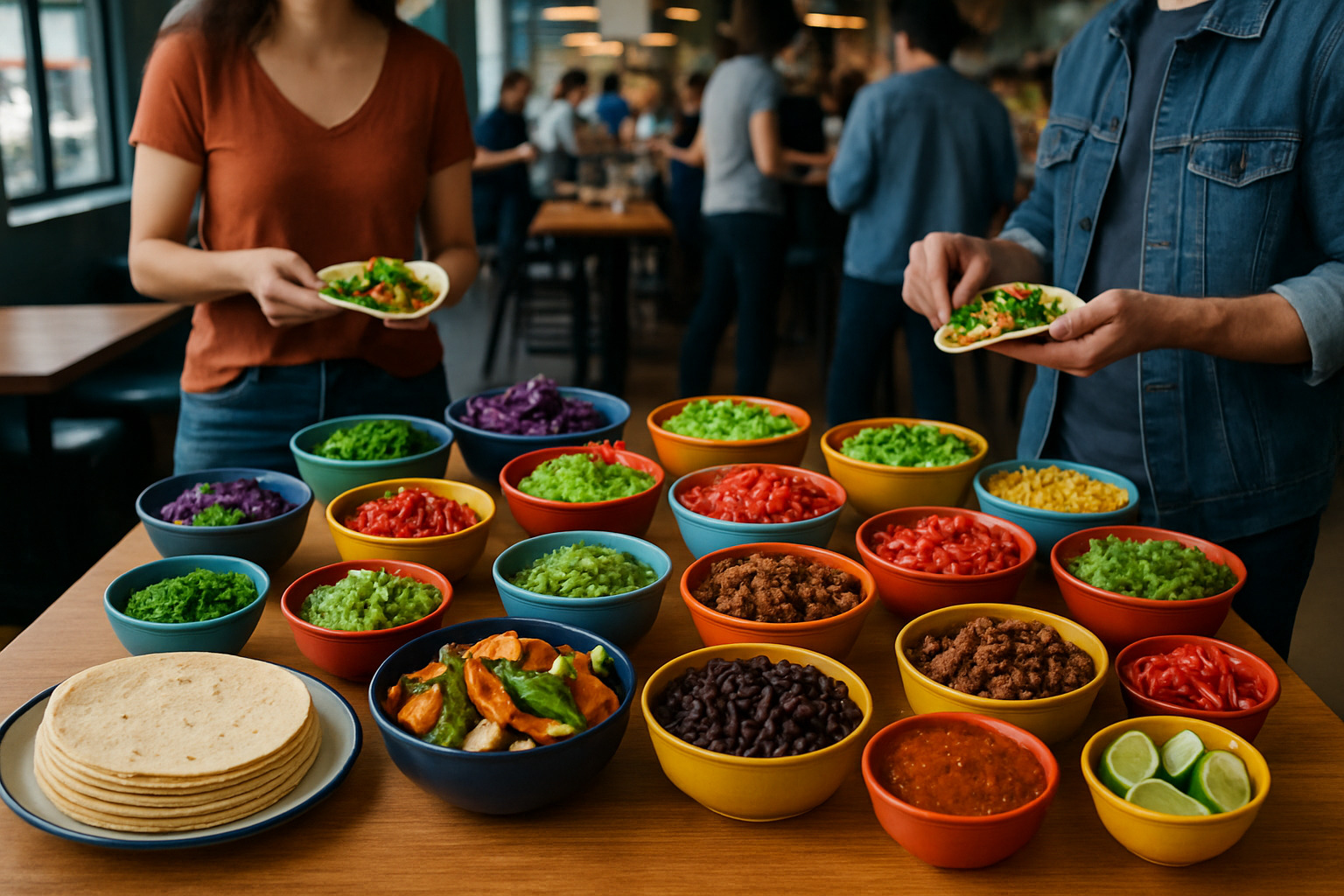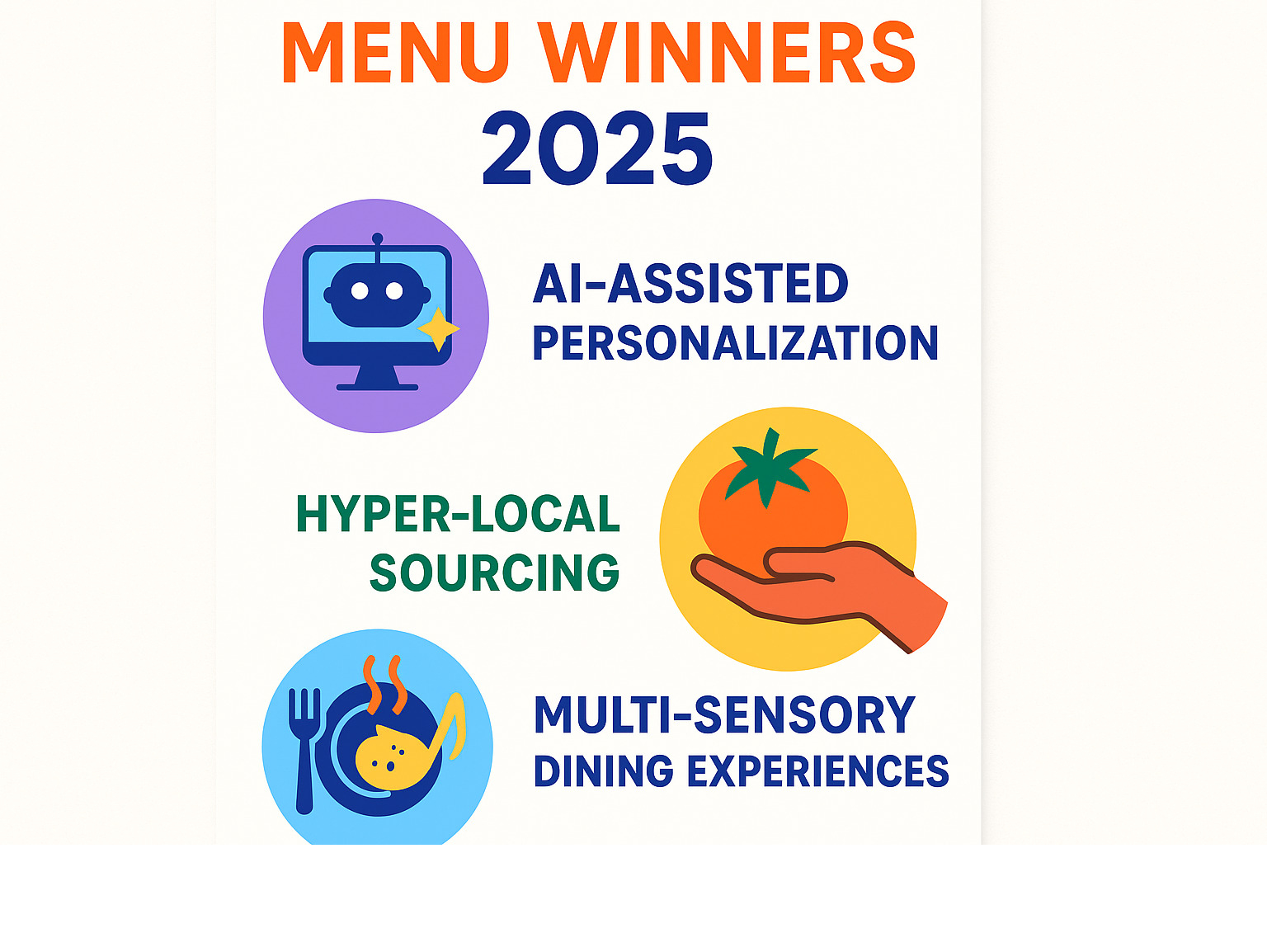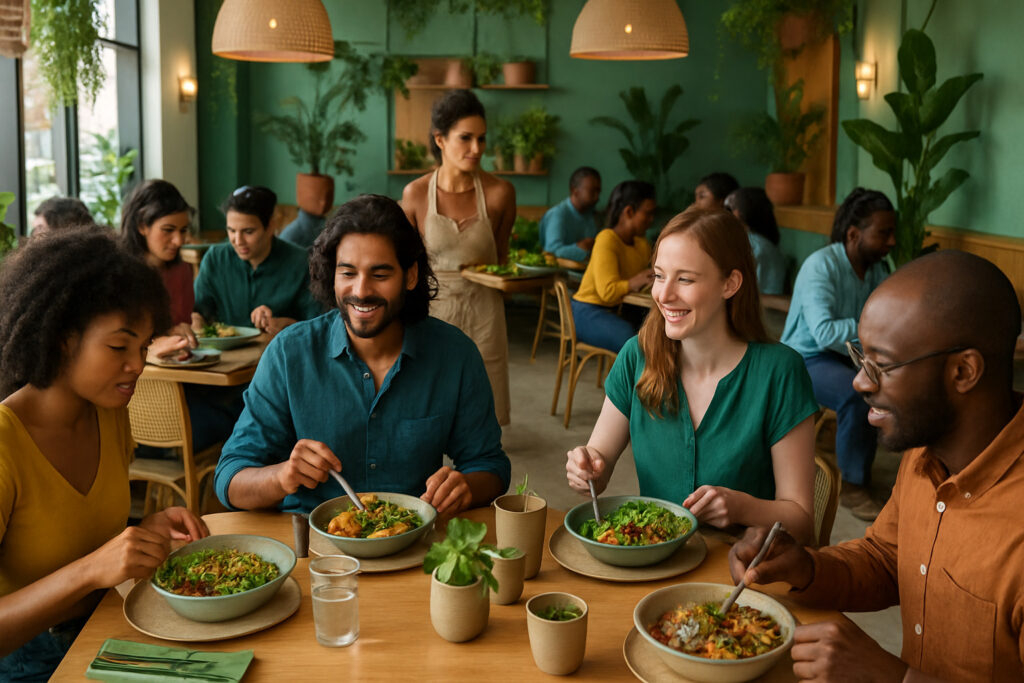Why the Dining Landscape Shifted Dramatically in 2023
Dining trends 2023 transformed how Americans eat out, driven by inflation, social media, and a hunger for authentic experiences. Here are the key trends that defined restaurant dining in 2023:
- Plant-based surge: Mushroom sales jumped 63% and oat milk increased 22.6%
- Global fusion: Southeast Asian flavors and “swicy” (sweet-spicy) combinations dominated menus
- Sustainability focus: Zero-waste practices became standard, not just trendy
- Experience-driven dining: Interactive food stations and open kitchens replaced traditional service
- Value-conscious choices: Grocery prices rose 13.0% vs restaurant prices at 8.5%, making dining out relatively more attractive
- Zero-proof revolution: Non-alcoholic cocktails gained serious culinary respect
The year 2023 marked a turning point where restaurants stopped treating diners as just customers and started viewing them as experience seekers. More than 70% of restaurant operators agreed that customers wanted to gather on-premises, hungry for connection as much as sustenance.
From cottage cheese ice cream going viral on TikTok to pickle-flavored everything jumping 89% on delivery platforms, 2023 proved that diners craved both comfort and trip. The era of Instagram-worthy plating merged with economic reality, creating a dining landscape where $65 entrees coexisted with creative value meals.
What made 2023 truly different was how restaurants adapted to post-pandemic life while navigating inflation pressures. The result? A year where mini dessert plates increased 37% at mid-scale restaurants, “swicy” flavors exploded across menus, and sustainability shifted from buzzword to business necessity.

Easy Dining trends 2023 glossary:
Dining trends 2023 in Review: What Stuck & What Slipped
The year 2023 delivered some surprising plot twists for American diners. While we all felt the pinch at grocery stores, restaurants quietly became the unexpected heroes of our wallets. Dining trends 2023 were shaped by a fascinating economic reality: grocery prices shot up a staggering 13.0% while restaurant menu prices rose by a more manageable 8.5%.
| Price Category | 2023 Inflation Rate |
|---|---|
| Grocery Prices | 13.0% |
| Restaurant Menu Prices | 8.5% |
This shift changed everything. Suddenly, that $16 restaurant salad didn’t feel quite so outrageous when a head of lettuce at the grocery store cost $6 – especially after California’s Salinas Valley got hit hard by crop-damaging insects that sent produce prices through the roof.
Smart restaurants acceptd menu streamlining as their secret weapon. Instead of overwhelming us with endless options, the best spots focused on perfecting fewer dishes. This wasn’t just about cutting costs – it was about delivering consistent, memorable experiences that kept customers coming back for more.
Shared plates made a comeback, but with a clever twist. Restaurants started getting specific about their portions, clearly marking dishes as “hors d’oeuvres for the table,” “to share between two,” or “individual portions.” This evolution perfectly captured our desire to eat together while solving the age-old problem of portion confusion.
The value bundle revolution became restaurants’ not-so-secret weapon for attracting budget-conscious diners. Family meal kits, breakfast deals, and bundled experiences offered real savings while keeping profit margins healthy.
Zero-waste initiatives transformed from feel-good marketing into serious business strategy. Restaurants began turning scraps into stocks, dehydrated seasonings, and creative garnishes. This wasn’t just about saving the planet – it was about squeezing every penny from ingredient purchases when prices kept climbing.
Top 5 Enduring Dining trends 2023
Dining trends 2023 established five major movements that continue shaping how we eat today, proving they had real staying power beyond the initial hype.
The plant-based surge went far beyond basic veggie burgers. Restaurants acceptd specialty mushrooms, jackfruit preparations, and creative tofu applications that actually tasted amazing. King oyster mushrooms became the breakout star, changing into convincing “scallops” and other seafood substitutes that impressed even dedicated carnivores.
Global fusion exploded into mainstream acceptance, with Korean-Mexican combinations, Indian-inspired pizzas, and Thai-Spanish tapas concepts winning over adventurous eaters. One in three consumers worldwide actively sought out these internationally inspired dishes, proving fusion wasn’t just a passing fad.
The sustainability focus shifted from optional to essential. Zero-waste cooking, local sourcing, and transparent ingredient labeling became standard expectations rather than nice-to-have features.
Zero-proof drinks evolved from afterthoughts into sophisticated beverages worthy of prime cocktail menu real estate. Bars started crafting spirit-free options with the same attention to detail as their alcoholic counterparts.
Finally, restaurants found that interactive dining experiences – from DIY food stations to open kitchens to customizable meal formats – increased both customer satisfaction and social media sharing.
Global Flavor Mash-Ups & Fusion Fever
The dining trends 2023 fusion revolution proved that today’s diners wanted their taste buds to travel the world, even when their wallets couldn’t. This wasn’t your typical “fusion confusion” of throwing random ingredients together – chefs finally learned to respect culinary traditions while creating genuinely exciting new combinations.
Southeast Asian influences completely transformed American menus in 2023. Suddenly, tamarind wasn’t just an exotic ingredient hiding in pad thai – it became the year’s breakout flavor star. Restaurants found that tamarind’s perfect sweet-tart balance made it ideal for everything from cocktail syrups to dessert sauces. The tangy fruit perfectly captured the “swicy” trend that defined the year, offering that complex sweet-and-spicy kick Americans couldn’t get enough of.
Floral flavors bloomed across menus with surprising sophistication. Gone were the days when lavender meant overperfumed ice cream that tasted like soap. Chefs began incorporating violet, elderflower, and lavender into savory dishes with remarkable skill. These weren’t just pretty garnishes – they added genuine depth to sauces, marinades, and even cocktails.
The “swicy” phenomenon became 2023’s signature taste profile, and for good reason. Honey-chili glazes, maple-harissa sauces, and brown butter-gochujang combinations satisfied America’s growing appetite for complex heat. This wasn’t about burning your tongue off – it was about creating layers of flavor that kept you coming back for another bite.
South American influences finally got their moment in the spotlight. Choripán sandwiches and birria tacos evolved from food truck specialties to upscale restaurant features. These dishes offered the comfort factor Americans craved while providing the global trip their palates demanded.
More info about The Flavor Fusion Trend
Scientific research on floral flavours
Dining trends 2023 Meet 2025: New Fusion Icons
Dining trends 2023 laid the groundwork for some of today’s most exciting fusion concepts. Seacuterie boards emerged as the clever seafood answer to traditional charcuterie, featuring house-smoked fish, creative condiments, and artisanal seafood preparations. These boards offered the luxury experience diners wanted at a more accessible price point than their meat-heavy predecessors.
Internationally-inspired sandwiches became the ultimate comfort-meets-trip food. Imagine Vietnamese banh mi techniques applied to classic American deli meats, or Korean bulgogi served on artisanal sourdough with house-made kimchi mayo.
Ube desserts dominated Instagram feeds and dessert menus alike. The purple yam’s naturally vibrant color made every dessert photo-ready, while its subtle vanilla-nutty flavor won over even skeptical diners. Gooseberry emerged as another unexpected fruit star, with its market projected to reach $1.92 billion by 2029.
Plant-Forward Power & Alternative Proteins
The plant-based revolution that defined dining trends 2023 wasn’t about fooling anyone into thinking vegetables were meat. Instead, restaurants finally started treating plants like the culinary stars they’ve always been, creating dishes that celebrated their unique textures, flavors, and nutritional power.
Mushrooms became the breakout stars of this movement, with specialty varieties experiencing an incredible 63% sales surge between 2012 and 2023. Oyster mushrooms transformed into convincing “scallops,” while lion’s mane varieties gained attention for their potential brain-boosting benefits. King oyster mushrooms became the go-to choice for creating meaty textures that satisfied even the most dedicated carnivores.
Restaurants began featuring mushroom “steaks” that rivaled traditional proteins in both presentation and satisfaction. These weren’t trying to be beef – they were proudly mushroom, with their earthy flavors improved through careful preparation techniques like slow roasting and herb crusting.
Jackfruit emerged as nature’s pulled pork, with its naturally stringy texture making it perfect for barbecue applications. Unlike heavily processed meat alternatives, jackfruit offered a whole-food approach that appealed to diners seeking cleaner ingredients. Its ability to absorb marinades and sauces made it incredibly versatile across different cuisines.
The lentil renaissance brought these humble legumes into the spotlight, not just for their impressive 9 grams of protein per half-cup, but for their environmental benefits. Lentils actually improve soil health by fixing nitrogen, making them a truly sustainable protein choice. Creative chefs transformed them into “meatballs,” rich pasta sauces, and colorful salads that looked as good as they tasted.
Oat milk continued its victory lap with a 22.6% sales increase in 2023. Smart restaurants expanded beyond coffee applications, incorporating oat milk into pancake batters, ice cream bases, and even savory cream sauces. Its naturally creamy texture and neutral flavor made it more versatile than other plant-based alternatives.
Even tofu got a makeover, shedding its bland reputation through innovative preparations. Restaurants showcased different tofu types – silken varieties for desserts, firm blocks for stir-fries, and tofu skin for creative wraps. The key was treating tofu as an ingredient with unique properties rather than a meat substitute.
More info about Sustainable Menu Options
From Dining trends 2023 to Flexitarian Mainstream
Dining trends 2023 laid the groundwork for today’s flexitarian approach, where plant-based options feel natural and integrated rather than segregated into a separate “vegetarian section.” This shift reflected how Americans actually eat – mostly plants with some animal proteins mixed in.
Urban produce partnerships became a game-changer for forward-thinking restaurants. Collaborations with local vertical farms and rooftop gardens provided ultra-fresh ingredients that could be harvested to order. These urban farming techniques used up to 98% less water than traditional agriculture, making them both environmentally smart and economically viable.
The specialty mushroom boom expanded beyond main dishes into cocktails, desserts, and even functional beverages. Lion’s mane mushrooms appeared in wellness-focused drinks, while shiitake found its way into surprising applications like mushroom ice cream and umami-rich cocktail syrups.
Swicy honey glazes represented the perfect fusion of plant-based ingredients with bold flavors. Restaurants combined local honey with chili-infused oils, creating versatile glazes that worked equally well on roasted vegetables, grilled proteins, and even desserts. This sweet-spicy combination captured the year’s most popular flavor profile while keeping ingredients simple and recognizable.
Experience-First Dining: Tech, Interactivity & Atmosphere
Dining trends 2023 completely changed what it meant to go out for dinner. Restaurants stopped being just places to eat and became full-blown entertainment experiences. The meal itself? That was just the opening act.
Think about the last time you walked into a restaurant and found yourself building your own tacos at a DIY station. That wasn’t an accident – it was part of a bigger shift toward making diners part of the show. Interactive food stations popped up everywhere, from sushi rolling workshops to build-your-own ice cream sundae bars. These setups did something clever: they turned eating into a social activity that naturally created conversation and laughter around the table.

The open kitchen concept evolved into something restaurants started calling “dinner theater.” Chefs became performers, tossing pizza dough, flambéing dishes, and hand-pulling noodles while diners watched from their seats. This wasn’t just about showing off – it built trust. When you can see exactly how your food gets made, you feel more connected to both the meal and the people preparing it.
Behind the scenes, artificial intelligence began quietly helping restaurants improve their game. Chefs used AI recipe testing tools to brainstorm new flavor combinations and analyze what customers actually ordered versus what they thought they wanted.
Restaurant design took a dramatic turn toward maximalist aesthetics. After years of stark, minimalist spaces, establishments acceptd bold colors, dramatic lighting, and immersive themes that made every corner Instagram-ready.
The influence of TikTok critics and food influencers reached unprecedented levels in 2023. A single viral video could transform an unknown dish into a must-have menu item overnight. Restaurants began designing dishes specifically for social media appeal, considering how they would look in a 15-second video clip as much as how they would taste.
One unexpected shift was the renaissance of late-night dining. With remote work blurring traditional meal times, restaurants extended their hours to capture diners who wanted dinner at 10 p.m. or dessert at midnight.
More info about The Rise of Experiential Dining
Pricing, Portions & Transparency
The economic reality of dining trends 2023 forced some uncomfortable conversations about what dinner actually costs. Premium entrées hitting $65 or higher became common, but successful restaurants learned to justify these prices through storytelling and exceptional experiences you couldn’t recreate at home.
Mini-desserts emerged as a brilliant solution to multiple problems at once. Instead of serving massive desserts that often went half-eaten, restaurants created sampler plates with three or four small treats. Diners got variety without waste, restaurants controlled costs, and everyone felt satisfied without being stuffed.
The tipping puzzle became genuinely confusing in 2023. Automatic service charges, suggested tip percentages starting at 20%, and general “tipping fatigue” left both diners and servers uncertain about expectations.
Clear sourcing labels became a competitive advantage rather than just a nice touch. Menus began reading like stories, mentioning specific farms, fishing methods, and production techniques.
Social Media’s Grip on Dining trends 2023 and Beyond
Dining trends 2023 cannot be understood without acknowledging how deeply social media influenced every dining decision. Restaurants had to master the art of creating dishes that looked spectacular in photos while still delivering on taste – a trickier balance than you might think.
The investment in Instagram-worthy plating became serious business. Restaurants hired food stylists, installed special lighting, and trained staff on optimal photo angles.
Micro dessert flights gained popularity partly because they created perfect social media content. A plate featuring multiple colorful small desserts offered more visual variety and sharing potential than a single slice of chocolate cake, no matter how delicious that cake might be.

The phenomenon of viral food trends extending far beyond their official availability became clear in 2023. Limited-time offers lived on through DIY recreations and social media challenges, keeping menu items relevant long after they disappeared from actual restaurant menus.
Beverage Innovations: Spirit-Free Sips to Martini Madness
The drink scene of dining trends 2023 witnessed a complete change that went far beyond just adding fancy garnishes to cocktails. This was the year when bartenders finally treated non-alcoholic beverages with the same respect as their boozy counterparts.
Zero-proof cocktails evolved from afterthoughts to menu stars. Skilled bartenders began using sophisticated techniques like clarification, fermentation, and even barrel-aging to create complex non-alcoholic drinks that satisfied grown-up taste buds. These weren’t your typical virgin mojitos – we’re talking about drinks with depth, complexity, and serious flavor profiles that made you forget they were alcohol-free.
The espresso martini craze reached absolutely wild heights in 2023. This coffee-meets-cocktail creation appeared on practically every bar menu from coast to coast. Its perfect marriage of caffeine and alcohol matched the late-night dining trend perfectly, while its gorgeous layered appearance made it pure social media gold.
Spicy “swalty” drinks became the liquid version of the swicy food trend. Creative bartenders started combining sweet, salty, and spicy elements in single beverages that made your taste buds do a happy dance. Think chili-infused simple syrups, smoked salt rims, and spicy garnishes that complemented the bold flavors dominating food menus.
Cocktail-flavored beers emerged as an unexpected hybrid category that nobody saw coming. These clever creations offered familiar cocktail flavors in beer format, appealing to beer lovers wanting something different and cocktail fans seeking lower alcohol options.
Functional beverages gained serious momentum as wellness culture merged with drinking culture. Adaptogenic ingredients, nootropics, and other wellness-focused additions started appearing in both alcoholic and non-alcoholic drinks.
Scientific research on brain-boosting beverages
Non-Alcoholic Boom After Dining trends 2023
Dining trends 2023 established non-alcoholic beverages as legitimate menu categories that deserved serious real estate alongside wine lists and cocktail menus. The sober-curious movement gained incredible momentum, with more people seeking sophisticated alternatives to traditional alcoholic drinks without feeling like they were missing out.
Oat milk cold brew became the undisputed champion of coffee shops and restaurants alike. Its naturally creamy texture and environmental benefits struck a chord with health-conscious consumers who wanted their caffeine fix without compromise.
THC seltzers and other cannabis-infused beverages gained legal ground in many markets, offering a completely different type of social experience for diners seeking alternatives to alcohol.
Hydration-focused waters packed with electrolytes, vitamins, and functional ingredients became standard menu offerings. These improved waters appealed to health-conscious diners while offering restaurants much better profit margins than traditional soft drinks.
Frequently Asked Questions about Dining trends 2023
What role did plant-based and alternative proteins play in Dining trends 2023?
Dining trends 2023 marked a turning point where plant-based proteins stopped trying to be something they weren’t and started celebrating what they actually were. Instead of creating another burger that tasted “just like beef,” restaurants began showcasing vegetables and alternative proteins for their unique qualities.
Specialty mushrooms became the breakout stars, with sales jumping an impressive 63% between 2012 and 2023. Restaurants found that king oyster mushrooms could be sliced and seared to create convincing “scallops,” while lion’s mane mushrooms offered a meaty texture that worked beautifully in tacos and stir-fries.
Jackfruit emerged as the perfect pulled pork alternative, not because it tasted like pork, but because its naturally stringy texture absorbed barbecue sauces beautifully. Unlike heavily processed meat substitutes, jackfruit offered a whole-food approach that appealed to health-conscious diners who wanted to know exactly what they were eating.
The real game-changer was how restaurants approached menu design. Rather than relegating plant-based options to a separate “vegetarian section,” successful establishments integrated these proteins throughout their menus. This flexitarian approach meant that even dedicated meat-eaters were trying and enjoying these dishes without feeling like they were making a sacrifice.
How did sustainability and local sourcing impact restaurant offerings in 2023?
Sustainability evolved from feel-good marketing to serious business strategy during dining trends 2023. With ingredient costs soaring, restaurants found that zero-waste practices weren’t just environmentally responsible – they were financially essential.
The most innovative establishments began treating food scraps like treasure. Vegetable trimmings became flavorful stocks, herb stems were dehydrated into seasonings, and even citrus peels found new life as garnishes and cocktail ingredients. This wasn’t just about reducing waste – it was about maximizing every dollar spent on ingredients during an inflationary period.
Local sourcing took on new meaning as restaurants partnered with urban farms and rooftop gardens. These relationships provided ultra-fresh ingredients while dramatically reducing transportation costs.
Transparency became the new luxury. Restaurants started listing specific farms, fishing methods, and production techniques directly on their menus. Diners were willing to pay premium prices when they understood the story behind their food – where it came from, how it was raised, and who grew it.
Which Dining trends 2023 should restaurateurs watch as we head into 2025?
The most enduring dining trends 2023 share one common thread: they prioritize human connection and authentic experiences over simple convenience.
Experiential dining continues gaining momentum because it addresses something delivery apps can’t replicate – the social aspect of sharing a meal. Interactive food stations, open kitchens that function as dinner theater, and customizable dining experiences create memories beyond just satisfying hunger.
Global fusion concepts that respectfully blend culinary traditions remain strong, particularly those featuring Southeast Asian influences and “swicy” flavor profiles. The success of these combinations suggests that diners’ appetite for culinary trip isn’t just a passing trend – it’s becoming the new normal.
Technology integration will become increasingly important, but not in the way many predicted. Instead of replacing human creativity, AI and social media optimization tools are helping restaurants better understand their customers and create more engaging experiences.
The zero-proof beverage revolution shows no signs of slowing down. Non-alcoholic cocktails now require the same attention to quality and creativity as traditional drink programs.
Perhaps most importantly, successful restaurants are learning to balance economic reality with experiential value. The establishments thriving post-2023 understand that diners will pay premium prices, but only when they receive genuine value – whether that’s exceptional ingredients, memorable experiences, or meaningful connections.
Conclusion

As we look back at dining trends 2023, it’s clear we witnessed more than just new menu items or fancy plating techniques. We saw restaurants fundamentally rethink their relationship with diners, changing from simple food providers into experience creators and community builders.
The trends that stuck around weren’t the flashy gimmicks or social media stunts. Instead, the lasting changes came from restaurants that understood what people truly craved after years of disruption: authentic connections, meaningful experiences, and food that tells a story.
Plant-based innovations proved they had staying power when chefs stopped trying to fool people with fake meat and started celebrating vegetables for what they actually are. Global fusion succeeded because it brought genuine cultural exchange to our plates, not just trendy ingredient combinations. Sustainability practices became standard because they made financial sense, not just environmental sense.
The economic reality of 2023 – where grocery inflation outpaced restaurant prices – created an unexpected opportunity. Restaurants that seized this moment didn’t just offer cheaper alternatives to home cooking. They provided something you couldn’t get at home: interactive experiences, expertly crafted cocktails, and the simple joy of being served.
Looking toward 2025, the most successful restaurants will be those that remember the lessons of dining trends 2023. Technology will continue advancing, but it won’t replace the human touch that makes dining special. AI-assisted personalization and hyper-local sourcing will become tools for creating better experiences, not replacements for genuine hospitality.
The future belongs to restaurants that can balance innovation with comfort, global influences with local identity, and efficiency with warmth. Whether you’re seeking the latest fusion creation or a perfectly executed classic, the trends that shaped 2023 continue guiding us toward a dining landscape that’s more connected, more sustainable, and more delicious than ever.
At The Dining Destination, we’re excited to continue exploring these evolving culinary stories with you. From New York City to destinations around the world, the trip of finding great food and meaningful dining experiences never ends.







